Name: Nature Coatings
Sector: New materials from processing waste
Pros: Organic-based black pigments as a by-product of the wood industry
Characteristics: These pigments have smaller environmental and health impacts compared to the carbon black pigments currently in use

“Over the last 15 years, I have invested in the idea of obtaining organic-based pigments that are as well-performing and as competitive as oil-based ones,” states Jane Palmer, CEO of Nature Coatings.
The American company uses waste material from the wood industry to produce a high-performance black pigment, a biobased alternative that can be used instead of the millions of tonnes of oil-derived carbon black that are made in the world each year. The two types of black pigment, SW and UR – which are currently being tested – are suited to multiple uses including printing on woven, leather, paper and plastic, packaging, coatings, dyes, resins and varnishes.
Carbon black pigments in use today are a source of pollution and dangerous to health. For every kilogram of carbon black pigment, 1.38kg of CO2 are generated. Furthermore, carbon black contains high levels of polycyclic aromatic hydrocarbons (PAHs), substances with damaging effects on the environment and both human and animal health. Black carbon pigments are used in textiles, paints, printer ink, car upholstery and cosmetic products.
Nature Coatings, which is working towards launching its first pigments on the market, uses wood waste from FSC-certified forests, and thanks to a circular process it doesn’t emit any further CO2 or greenhouse gases. The pigments it produces contain 90-100% less PAHs compared to carbon black, and are also suitable for use on bioplastics.



